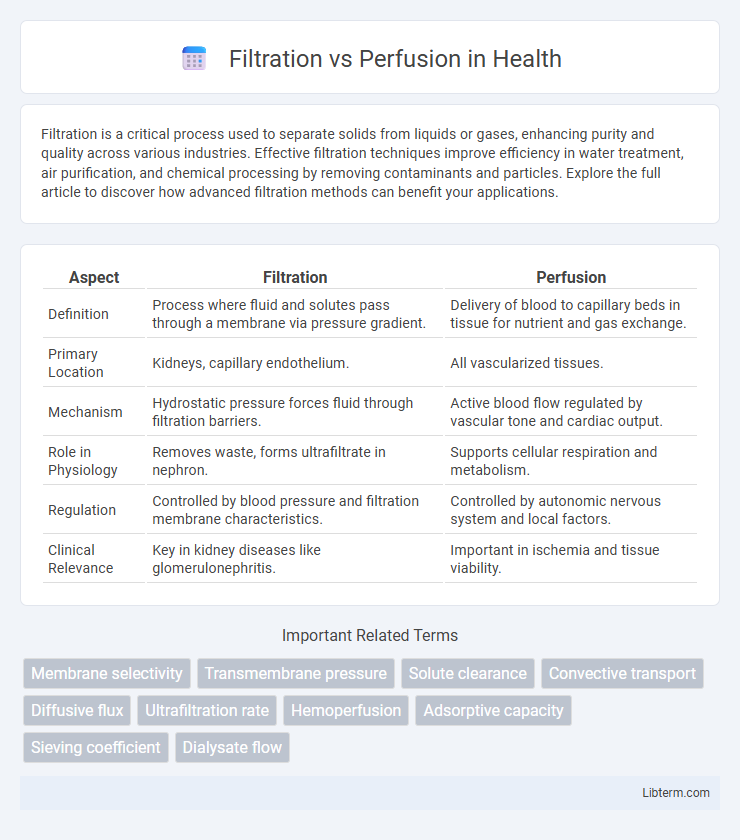Filtration is a critical process used to separate solids from liquids or gases, enhancing purity and quality across various industries. Effective filtration techniques improve efficiency in water treatment, air purification, and chemical processing by removing contaminants and particles. Explore the full article to discover how advanced filtration methods can benefit your applications.
Table of Comparison
| Aspect | Filtration | Perfusion |
|---|---|---|
| Definition | Process where fluid and solutes pass through a membrane via pressure gradient. | Delivery of blood to capillary beds in tissue for nutrient and gas exchange. |
| Primary Location | Kidneys, capillary endothelium. | All vascularized tissues. |
| Mechanism | Hydrostatic pressure forces fluid through filtration barriers. | Active blood flow regulated by vascular tone and cardiac output. |
| Role in Physiology | Removes waste, forms ultrafiltrate in nephron. | Supports cellular respiration and metabolism. |
| Regulation | Controlled by blood pressure and filtration membrane characteristics. | Controlled by autonomic nervous system and local factors. |
| Clinical Relevance | Key in kidney diseases like glomerulonephritis. | Important in ischemia and tissue viability. |
Introduction to Filtration and Perfusion
Filtration and perfusion are critical physiological processes essential for maintaining tissue homeostasis and overall organ function. Filtration refers to the movement of fluid and solutes across a selectively permeable membrane driven primarily by hydrostatic pressure differences, as prominently seen in renal glomeruli. Perfusion involves the delivery of oxygenated blood through capillaries to tissues, ensuring nutrient exchange and waste removal at the cellular level.
Defining Filtration: Principles and Processes
Filtration is a fundamental physiological process involving the movement of fluid and solutes across a semipermeable membrane driven primarily by hydrostatic pressure differences. It occurs in the kidneys' glomeruli, where blood pressure forces water and small molecules from the capillaries into the Bowman's capsule, excluding larger proteins and cells. This selective separation underlies fluid balance and waste elimination, distinct from perfusion, which refers to the flow of blood through tissues delivering oxygen and nutrients.
Understanding Perfusion: Concepts and Mechanisms
Perfusion refers to the process by which blood delivers oxygen and nutrients to tissues through the capillary network, ensuring cellular metabolism and homeostasis. It involves the regulation of blood flow, pressure gradients, and vascular resistance to maintain adequate tissue oxygenation and waste removal. Understanding perfusion mechanisms includes examining factors such as cardiac output, capillary permeability, and the role of microcirculation in tissue health.
Key Differences Between Filtration and Perfusion
Filtration involves the movement of fluid across a membrane driven by pressure differences, primarily removing particles based on size and membrane permeability. Perfusion refers to the passage of blood through the capillaries in tissue, ensuring adequate delivery of oxygen and nutrients while removing waste products. Key differences include filtration's reliance on hydrostatic pressure for fluid separation, whereas perfusion emphasizes blood flow rate and tissue oxygenation efficiency.
Applications of Filtration in Industry and Medicine
Filtration is extensively applied in industry for purifying liquids and gases, such as in water treatment plants, chemical manufacturing, and food processing, where it removes impurities and contaminants to ensure product quality and safety. In medicine, filtration plays a crucial role in hemodialysis, where blood is filtered to remove waste products and excess fluids in patients with kidney failure, and in pharmaceutical production to sterilize solutions and separate particles. Advanced filtration technologies, including membrane and microfiltration systems, enhance efficiency and precision across these critical applications.
Role of Perfusion in Biological and Medical Contexts
Perfusion refers to the process of delivering blood to the capillary bed in biological tissues, ensuring oxygen and nutrient supply as well as waste removal essential for cellular function and survival. In medical contexts, perfusion assessment is critical for diagnosing and managing conditions like ischemia, stroke, and organ transplant viability by evaluating blood flow adequacy to target tissues. Techniques such as perfusion MRI, CT perfusion imaging, and laser Doppler flowmetry quantitatively measure tissue perfusion, guiding therapeutic interventions and optimizing patient outcomes.
Advantages and Limitations of Filtration
Filtration offers precise separation of particles based on size, enabling effective removal of contaminants in liquids and gases with relatively low energy consumption. However, filtration can be limited by membrane fouling, clogging, and reduced flow rates over time, requiring frequent maintenance or replacement. Unlike perfusion, filtration does not support continuous nutrient exchange in biological systems, which restricts its application in long-term cell culture or tissue engineering.
Benefits and Challenges of Perfusion
Perfusion enhances tissue oxygenation and nutrient delivery by maintaining continuous blood flow, which is crucial for organ viability and function in medical treatments like organ transplantation and critical care. Benefits include improved metabolic waste removal and precise control over blood flow dynamics, reducing ischemic damage. Challenges involve complexity in monitoring, potential for vascular injury, and the need for specialized equipment and expertise to avoid complications such as thrombosis or hemolysis.
Choosing Between Filtration and Perfusion: Decision Factors
Choosing between filtration and perfusion depends on factors such as the desired separation efficiency, sample type, and flow rate requirements. Filtration is optimal for removing particles based on size exclusion, while perfusion targets enhanced mass transfer for improved solute exchange in biological systems. Selecting the appropriate method involves evaluating membrane properties, pressure conditions, and the compatibility with the specific application.
Future Trends in Filtration and Perfusion Technologies
Future trends in filtration and perfusion technologies emphasize enhanced precision and scalability through the integration of AI-driven automation and real-time monitoring systems. Advances in membrane materials and microfluidic devices aim to improve selectivity and efficiency in both blood filtration and organ perfusion applications. Emerging biofabrication techniques promise customizable filtration membranes and perfusion platforms, accelerating personalized medicine and regenerative therapies.
Filtration Infographic

 libterm.com
libterm.com